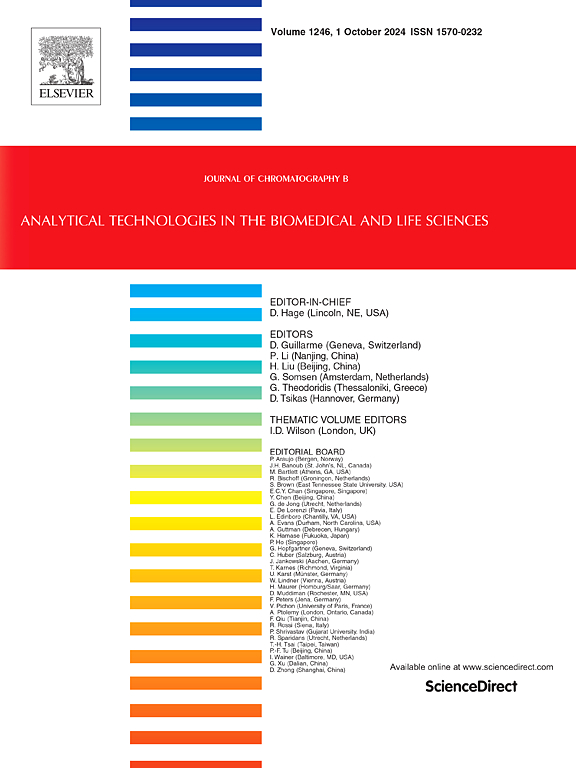百里香精油中百里香酚制备高效液相色谱法的优化
IF 2.8
3区 医学
Q2 BIOCHEMICAL RESEARCH METHODS
引用次数: 0
摘要
药物研究和质量控制对高纯度生物活性化合物的需求日益增长,这凸显了制备型高效液相色谱的关键作用。介绍了一种新型高效液相色谱(HPLC)高效液相色谱法(HPLC),用于大规模纯化荆草精油中百里香酚。解决了一个显着的知识差距,这是首次报道的应用Prep-HPLC从这种特定的植物源分离百里香酚,建立一个新的,可扩展的协议。建立了以甲醇:水(60:40,v/v)为优化条件的初始HPLC分析方法,并成功地扩展到半制备水平。优化后的制备方法以甲醇:水(90:10,v/v)为流动相,百里香酚的纯度达到了98.87%。通过全面的光谱分析,包括GC-MS, FTIR, XRD和NMR,明确了纯化化合物的结构特性。关键是,纯化的百里香酚对白色念珠菌和耳念珠菌的易感和多重耐药菌株均表现出有效的广谱抗真菌活性。对耐多药白色念珠菌的最低抑制浓度为0.125 μg/mL,对耐多药耳念珠菌的最低抑制浓度为0.25 μg/mL。这种强大的功效,特别是对具有挑战性的耐药分离株,强烈地表明纯化的百里香酚是进一步治疗念珠菌病的有希望的候选者。这项研究极大地推动了分离科学的发展,凸显了制备-高效液相色谱在高价值天然产物分离方面的工业潜力。本文章由计算机程序翻译,如有差异,请以英文原文为准。
Optimization of preparative HPLC method for the purification of thymol from the essential oil of Trachyspermum ammi (L.)
The escalating demand for high-purity bioactive compounds in pharmaceutical research and quality control underscores the critical role of preparative High-Performance Liquid Chromatography. This study introduces a novel and optimized preparative HPLC protocol for the large-scale purification of thymol from Trachyspermum ammi (L.) essential oil. Addressing a notable knowledge gap, this is the first reported application of Prep-HPLC for thymol isolation from this specific botanical source, establishing a new, scalable protocol. An initial analytical HPLC method, optimized with Methanol:Water (60:40, v/v), was successfully scaled to a semi-preparative level. The optimized preparative method, utilizing Methanol:Water (90:10, v/v) as the mobile phase, achieved thymol purification with an impressive 98.87 % purity. The structural identity of the purified compound was unequivocally confirmed through comprehensive spectroscopic analyses, including GC–MS, FTIR, XRD, and NMR. Crucially, the purified thymol exhibited potent and broad-spectrum antifungal activity against both susceptible and multidrug-resistant strains of Candida albicans and Candida auris. Minimum inhibitory concentrations were determined to be as low as 0.125 μg/mL against multidrug-resistant C. albicans and 0.25 μg/mL against multidrug-resistant C. auris. This robust efficacy, particularly against challenging drug-resistant isolates, strongly positions the purified thymol as a promising candidate for further therapeutic development against candidiasis. This research significantly advances separation science and highlights the industrial potential of Prep-HPLC for high-value natural product isolation.
求助全文
通过发布文献求助,成功后即可免费获取论文全文。
去求助
来源期刊

Journal of Chromatography B
医学-分析化学
CiteScore
5.60
自引率
3.30%
发文量
306
审稿时长
44 days
期刊介绍:
The Journal of Chromatography B publishes papers on developments in separation science relevant to biology and biomedical research including both fundamental advances and applications. Analytical techniques which may be considered include the various facets of chromatography, electrophoresis and related methods, affinity and immunoaffinity-based methodologies, hyphenated and other multi-dimensional techniques, and microanalytical approaches. The journal also considers articles reporting developments in sample preparation, detection techniques including mass spectrometry, and data handling and analysis.
Developments related to preparative separations for the isolation and purification of components of biological systems may be published, including chromatographic and electrophoretic methods, affinity separations, field flow fractionation and other preparative approaches.
Applications to the analysis of biological systems and samples will be considered when the analytical science contains a significant element of novelty, e.g. a new approach to the separation of a compound, novel combination of analytical techniques, or significantly improved analytical performance.
 求助内容:
求助内容: 应助结果提醒方式:
应助结果提醒方式:


